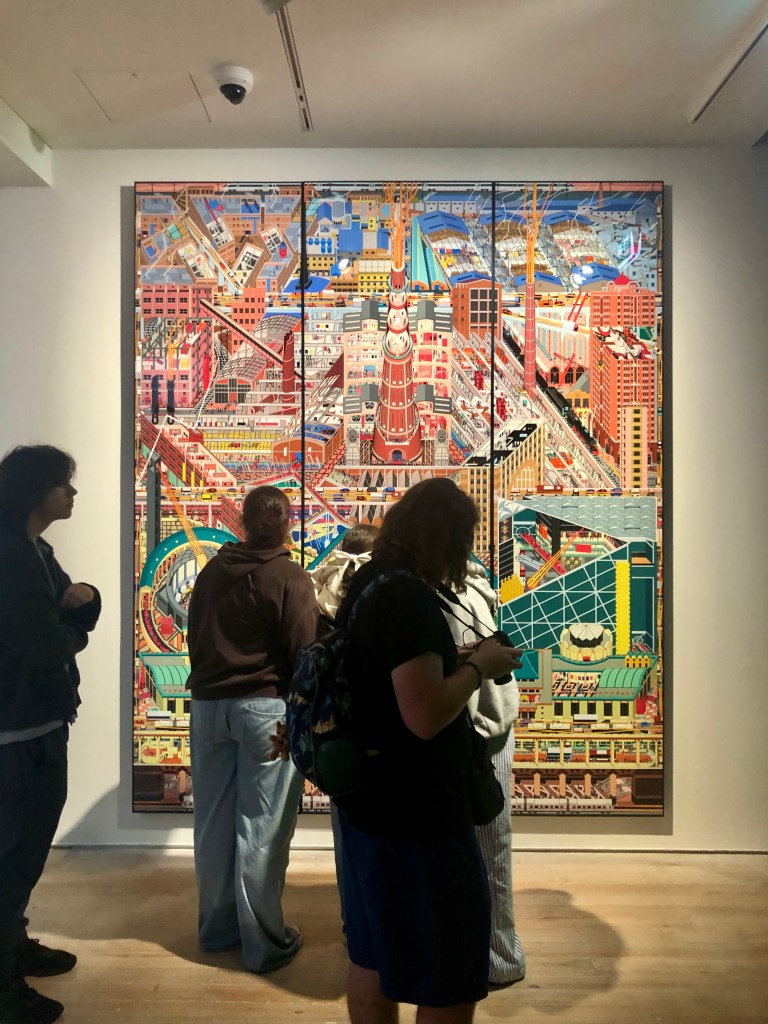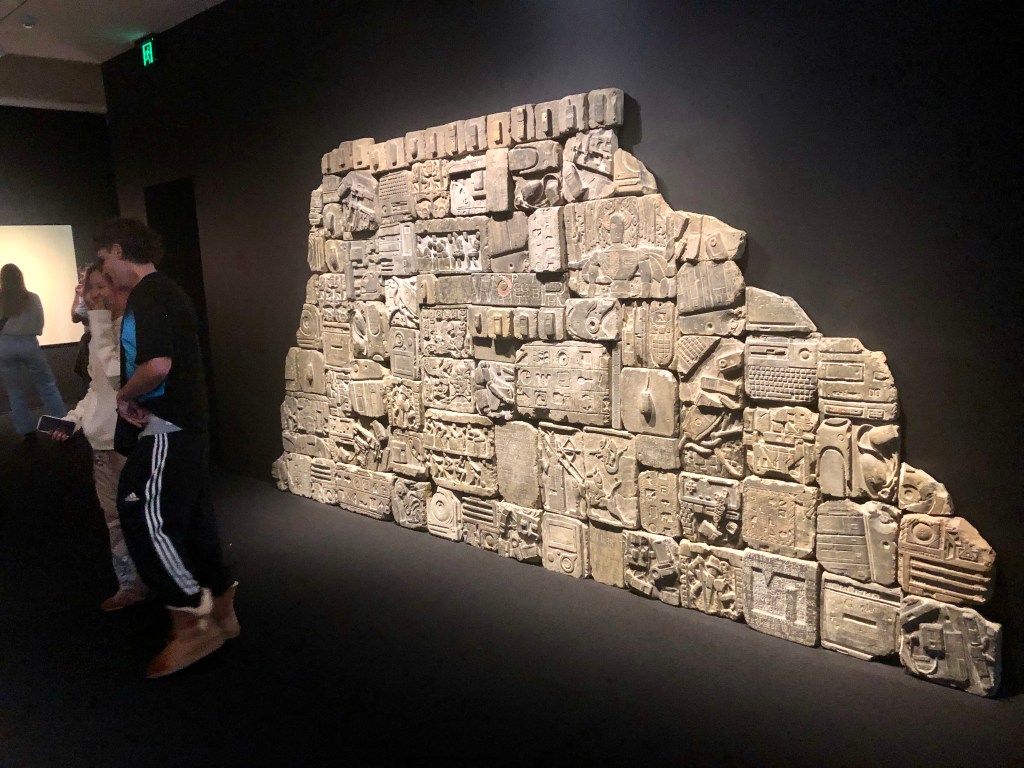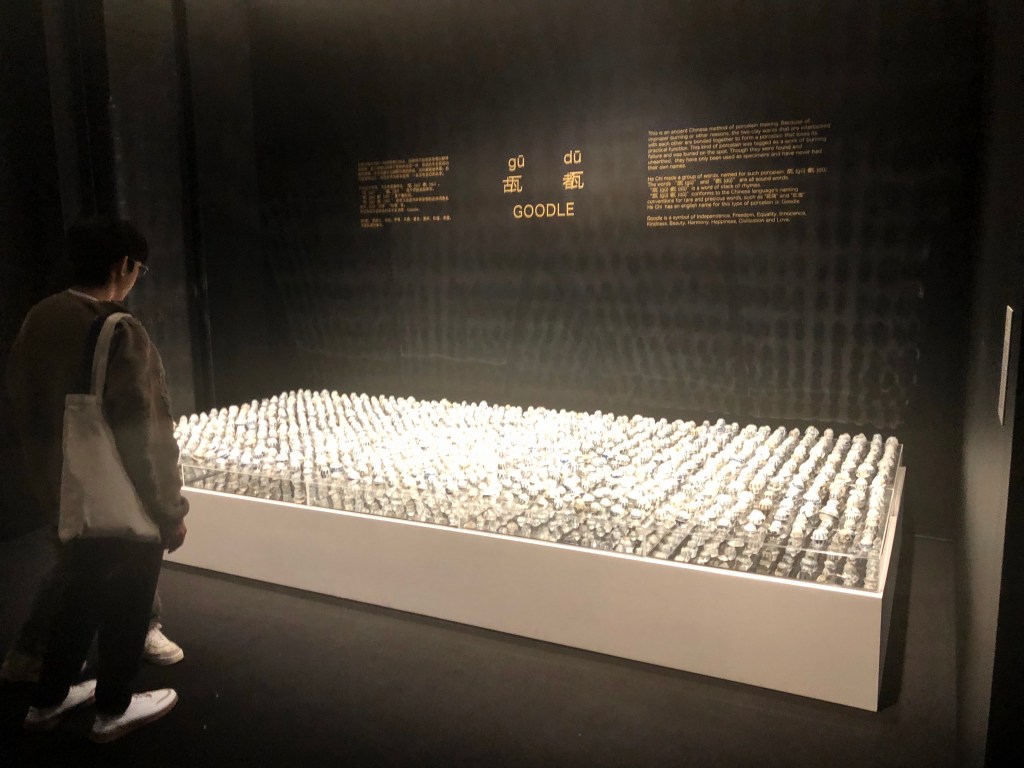
Sydney’s White Rabbit Gallery rarely disappoints. It shows contemporary Chinese work of exceptional quality. I have written about this elsewhere. But I was startled again by the quality of the craft, by the formidable layers of meaning and by the absolute self-confidence of the expression. No self-censorship. None. Some of the work comes from Chinese artists working in Australia, but most of it comes from mainland China. A reminder once more that the world as constructed by the media is an imperfect representation of reality.
I met my friend below somewhere near the entrance as inches of rain fell on Chippendale. The three works we are looking at were all to some degree show-stoppers. On the left looking like sheets of Pantone colours was I think ‘Library’ or possibly and more interestingly ‘Bibliography’. [It’s actually called ‘Bibliotheque’. That could make me half right or twice right. Okay … half right, or less.] On the right is a painting of a bedraggled horse being lowered from a ship. During the First World War, China sent thousands of horses in freight ships to support the Allied war effort. These horses have apparently been a popular subject in Chinese art and are usually portrayed in warrior-like poses, rearing and snorting, desperate to launch into the fray. This artist took an alternative view. In the middle is a very precise model (at 1:20) of the US Capitol building made from wood by 20 artisans over 8 months. Tilting. Unstable. ‘Freedom’, the statue on top, looks remarkably like a Buddhist bodhisattva. I had never noticed that before.
But the photo has four parts and the not least wonderful is the attendant. I asked if I could take his photo just there. We looked at the set-up together and he could see what I meant. I took the photo and he got his copy. But it struck me that in a gallery how much the people looking, the spectators, become the spectacle. I thought I’d take photos of the works as I, and others, saw them. Including the others.

The exhibition itself is founded on a killer idea.
A BLUEPRINT FOR RUINS
REVERBERATING WITH THE SHADOWS OF THE DISPOSSESSED WITHIN CHINA’S URBAN METAMORPHOSIS.
Beneath the glossy surface of progress lurks a simmering undercurrent of violence. Cities tear themselves apart to make way for towering skyscrapers and gleaming high-rises. However, in this bright new world, one question arises: where have all the people gone? Streets devoid of life and vacant apartment blocks stand as haunting reminders of an abandoned dream. Like solemn tombs from a long-lost civilisation, these forgotten monuments silently bear witness to the cost of rapid urbanisation, where each new creation necessitates the destruction of another.
Anyone who has seen contemporary Chinese cities will know what that’s about. It is both a foreign experience and an experience of foreign-ness to be looking at the endless rows of tower blocks (built at least partly with Australian iron ore, the foundation of our economy) some of which are lived in, but the conspicuous feature is how many aren’t. The theory? We build housing to drive the economy to provide jobs to keep spending ticking over to sustain the economy to build more housing to … I thought of this as an ouroboros, the very ancient idea of a serpent consuming its tail often used to suggest the ‘nothing ever really new-ness’ of life. But it’s not like that. There is no metaphysical or cultural edge. This is an economic adventure, and the dialectics of its materialism will be resolved. An end point will be reached. Inevitably.
But that’s all by the way.
* * * * * * *


A group of architects using their digital engineering drawing software to have fun.


Empty dance hall, slightly vertiginous mirrored entry, collapsed mirror balls, a pole dancer’s pole, a photo of a magician in his box impaled by swords, empty bar, empty bottles, a coat check with a leather jacket chained to the rack … this was the party piece.

Missed the tag. But you get the idea: lost items, in the broadest sense.


Six screens with slides constantly flicking through them, with voices over apparently reading from their diaries, with sub-titles in both Mandarin and exactly rendered English translation (which made them look, and sound, odd). The topics are mostly about domestic transitions, and just how you live and how you can live in different environments. Utterly absorbing.


Looking at first glance like ancient Sumerian tiled masonry, looking closer you can see the decoration on the stones: computer parts, mice (mouses?), people at work in an office setting and so on.

Missed the tag and wasn’t overwhelmed by the two pieces but pleased that the attendant agreed to smile at me in the mirror. She took her copy too. An art event.

We are looking at 1000 mis-fired porcelain cups, quite a puzzle to look at. They are sitting above a mirrored surface and it appears that what you’re looking at is identical to the reflection. It takes a moment or two to realise that they are doubled, similar cups fused together around their lips, top to bottom. Similar, but none of the pieces is the same. They were originally fired hundreds of years ago, discarded and buried. He Chi has somehow unearthed them and turned them into this display of transformation, common utensils become something quite different.
He Chi made up a name, ‘Goodle’, for this sort of failed porcelain. The characters for the rhyming sounds ‘gu’ and ‘du’ conform to the Chinese conventions for rare and precious words with an added flourish of English-ity. ‘Goodle’, he says somewhat ambitiously but why not, is a symbol for Independence, Freedom, Equality, Innocence, Kindness, Beauty, Happiness, Civilisation and Love.
* * * * * * *

There is a Chinese saying: ‘Men are reliable when pigs can climb trees’. And here pigs are cavorting most gaily in the branches of a bronze tree. No one in the picture but it was a wonderful piece for a final note.

Despite the Chinese contribution to the European civil war, the Treaty of Versailles granted all Chinese territory controlled by Germany to the Japanese; thus prolonging the prostration of China to the world Powers.
Those supporting the drum beat of war against China (just about everyone) would do well to brush up on history.